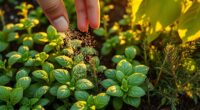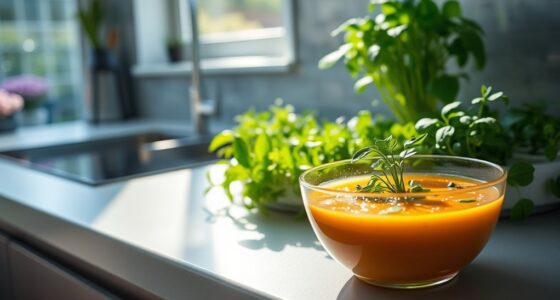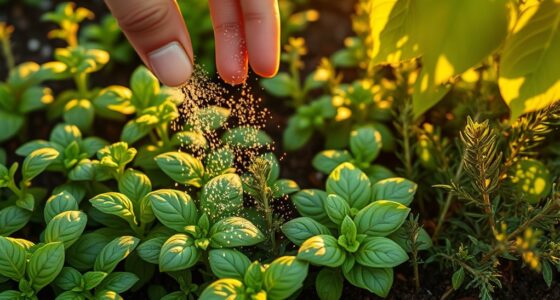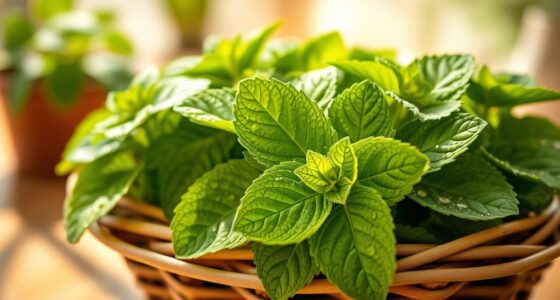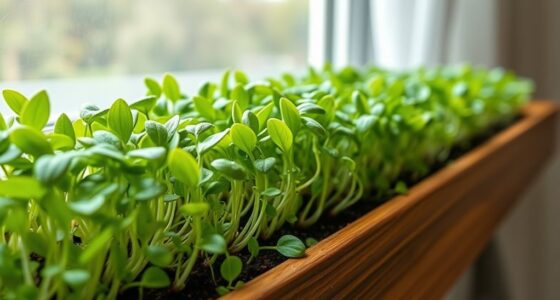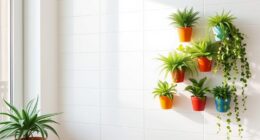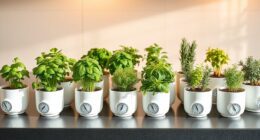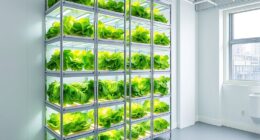To grow and use edible flowers in your smart garden, choose compact varieties like nasturtiums, pansies, or calendula, and make certain they get ample sunlight, water, and well-draining soil. Regularly prune, watch for pests, and harvest blooms at peak freshness—full color and open petals—preferably in the morning. Incorporate flowers into dishes, drinks, or garnishes, and consider drying extras for later. Keep exploring for tips to maximize your edible garden’s beauty and flavor potential.
Key Takeaways
- Select easy-to-grow edible flowers like nasturtiums, calendula, and pansies suitable for small, smart garden spaces.
- Use quality tools and organic pest management to ensure healthy, pest-resistant plants.
- Amend soil with compost, maintain proper pH (6.0–7.0), and ensure consistent watering for optimal growth.
- Harvest flowers at peak bloom, handling them gently and storing in the fridge to preserve freshness.
- Incorporate harvested flowers into dishes or preserve them via drying for long-term use and decorative presentations.
Getting Started With Edible Flowers in Your Smart Garden

Starting your smart garden with edible flowers is an exciting way to add beauty and flavor to your space. To begin, choose flowers that offer appealing color combinations, creating visual harmony and attracting pollinators. Understanding pollination strategies is key; some flowers rely on bees, butterflies, or even hummingbirds. Plant a variety of edible blossoms to encourage diverse pollinators, which boosts growth and yields. Guarantee your garden’s environment supports pollinator activity by providing a mix of sun, water, and shelter. Start small with easy-to-grow varieties, paying attention to their specific needs for soil, watering, and sunlight. Providing the right conditions can also enhance pollination success and improve your garden’s productivity. This foundation sets the stage for a vibrant, productive garden that’s both beautiful and beneficial.
Best Edible Flower Varieties for Small Spaces
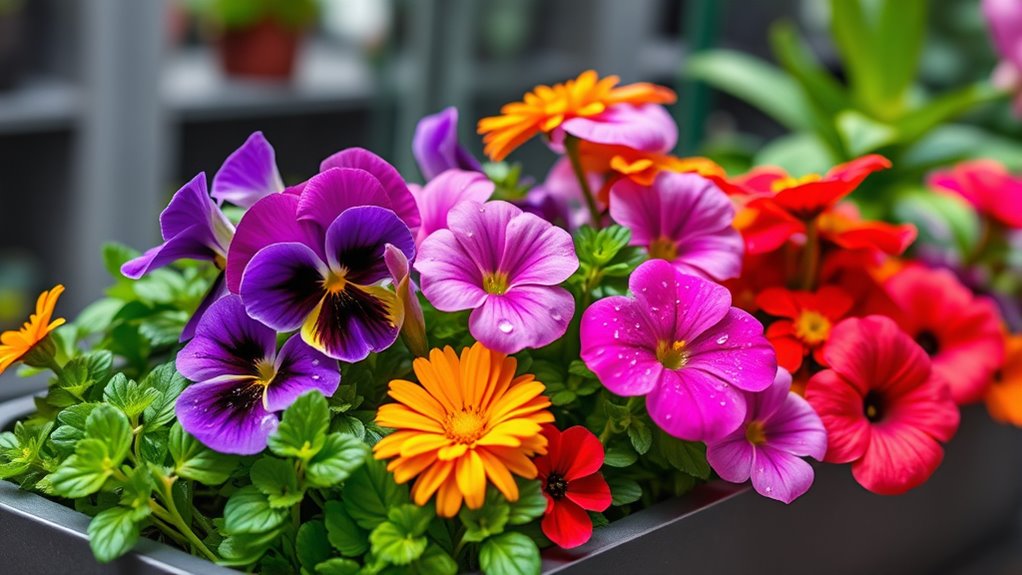
If you’re limited on space but want to enjoy the beauty and flavor of edible flowers, several compact varieties are perfect for small gardens or containers. Nasturtiums are a top choice; their vibrant flower color ranges from red to orange and yellow, adding a lively touch to your garden design. Calendula offers cheerful orange or yellow blooms and is easy to grow in tight spaces. Viola or pansies bring a delicate, colorful display with flower colors spanning purple, yellow, and white, enhancing any container. Sweet alyssum provides a fragrant ground cover with tiny white or purple flowers, ideal for small beds. These varieties maximize visual appeal and flavor while fitting into limited spaces, making your smart garden both beautiful and productive. Additionally, understanding the weight of items like pinball machines can be useful if you plan to incorporate elements like decorative garden features or small-scale game zones into your garden space.
Essential Smart Gardening Tools and Techniques
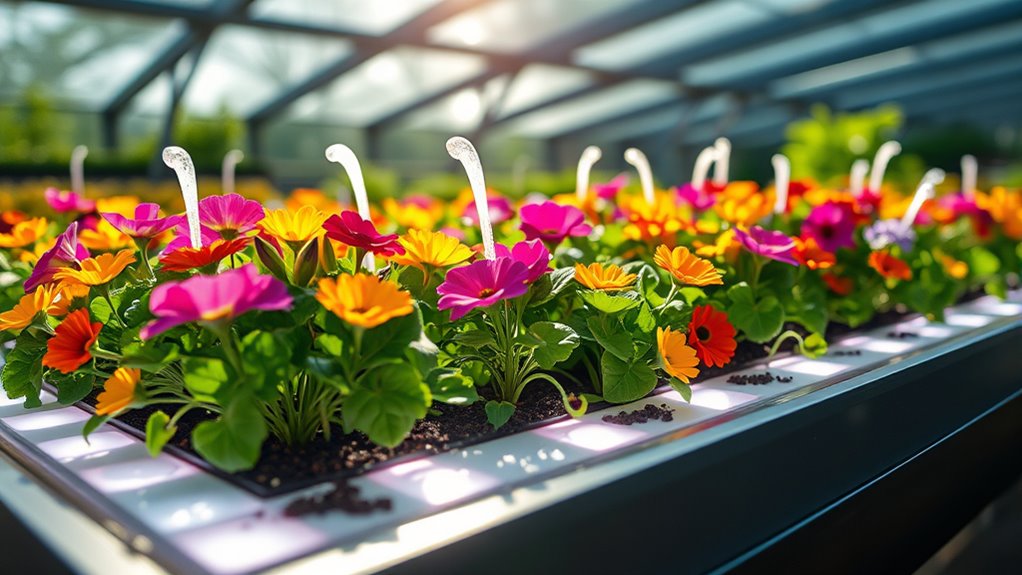
To successfully cultivate and maintain your edible flowers in a smart garden, having the right tools and techniques is key. Start with quality gardening tools like pruning shears and a moisture meter to monitor soil health. Regular soil testing helps you determine nutrient levels and pH, ensuring ideal growing conditions. Pest management is essential; use organic options like neem oil or insecticidal soap to keep pests at bay without harming your plants. A soil thermometer can help you maintain proper temperature, while a spray bottle allows for gentle watering and pest control. Keep your garden organized with labeled containers and a watering system that conserves water. Additionally, understanding Fokos can provide valuable insights into creating a balanced and sustainable garden environment. These tools and techniques will help you create a healthy environment for your edible flowers to thrive.
Planting and Caring for Edible Flowers
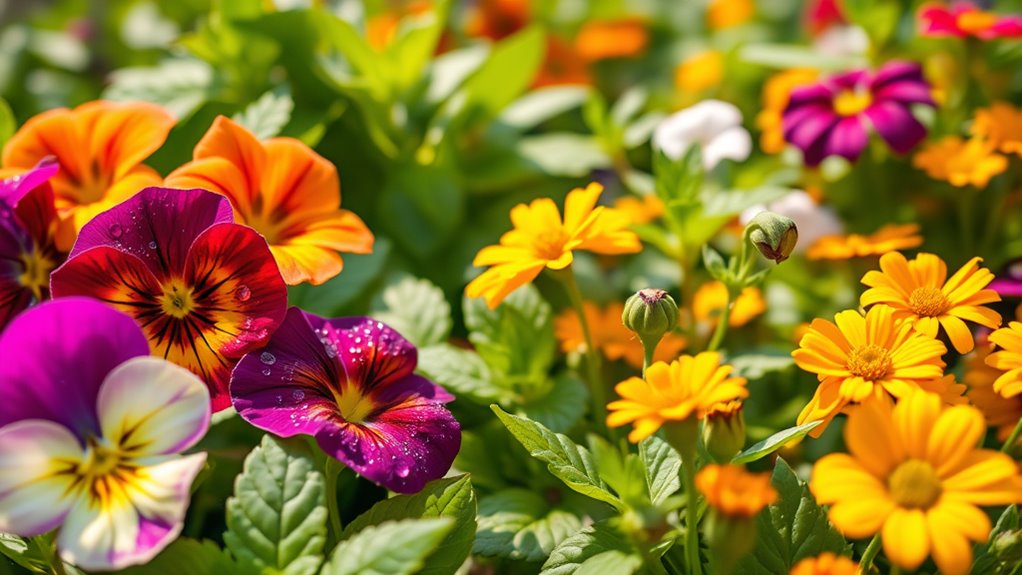
To successfully grow edible flowers, you need to choose suitable varieties that thrive in your climate. Make sure your soil has the right nutrients and drainage to support healthy growth. Regular watering and maintenance are essential to keep your flowers vibrant and productive. Additionally, staying vigilant about potential cybersecurity vulnerabilities can help protect your gardening data and smart garden systems from online threats.
Selecting Suitable Varieties
Choosing the right edible flower varieties is essential for a successful smart garden. When selecting, consider how pollination techniques will affect flower production; some plants rely on specific pollinators or manual pollination to thrive. Opt for varieties that naturally attract pollinators like bees and butterflies, boosting yields. Additionally, think about pest management—choose pest-resistant varieties or those less prone to common pests to reduce chemical use. Look for plants with disease resistance and adaptability to your climate. Some flowers, such as pansies or nasturtiums, are hardy and low-maintenance, making them ideal for smart gardens. Proper selection helps guarantee healthy growth, vibrant blooms, and a continuous supply of edible flowers for culinary use. Incorporating contrast ratio considerations into your gardening setup can improve the visibility and appeal of your flowers.
Optimal Soil Conditions
Selecting the right flower varieties sets the foundation for a thriving smart garden, but proper soil conditions guarantee those plants reach their full potential. To optimize growth, amend your soil with organic matter like compost or aged manure, which improves texture and fertility. Guarantee the soil has the correct pH balance—most edible flowers prefer a slightly acidic to neutral pH, around 6.0 to 7.0. You can test your soil with a simple kit and adjust as needed, adding lime to raise pH or sulfur to lower it. Good soil conditions promote healthy root development, stronger stems, and vibrant blooms. Regularly checking and maintaining the pH balance, along with appropriate amendments, creates an ideal environment for your edible flowers to flourish in your smart garden.
Watering and Maintenance
Proper watering and consistent maintenance are essential for ensuring your edible flowers thrive. You should monitor soil moisture regularly, keeping it evenly moist but not waterlogged. Establish a reliable watering schedule, watering early in the morning or late in the afternoon to prevent evaporation and fungal issues. Avoid letting the soil dry out completely, as this stresses the plants and hampers growth. Use a gentle spray or drip irrigation to deliver water directly to the roots, promoting healthy development. Additionally, remove any weeds and deadhead spent flowers to encourage continuous blooming. Regularly check for pests or diseases, addressing problems promptly. Maintaining proper soil moisture and a steady watering routine helps your edible flowers stay healthy, vibrant, and productive throughout the season. Incorporating remote work benefits such as flexible scheduling can also make it easier to dedicate focused time to plant care and maintenance.
Managing Water, Light, and Soil Conditions

Have you considered how crucial water, light, and soil conditions are for growing healthy edible flowers in your smart garden? Proper management starts with consistent watering, which a drip irrigation system provides efficiently, ensuring your plants receive steady moisture without overwatering. Light is equally important; most edible flowers thrive in full sun, so position your garden accordingly or use grow lights if needed. Soil conditions also matter—aim for a soil pH between 6.0 and 7.0, which you can monitor with a simple test kit. Adjust soil acidity or alkalinity as necessary to promote healthy growth. Regular maintenance and awareness of toilet functionality issues can help prevent problems that might impact your garden setup, such as plumbing leaks or water waste. By fine-tuning these factors, you create an ideal environment that supports vibrant, flavorful edible flowers, maximizing your garden’s productivity and beauty.
Harvesting Edible Flowers at the Perfect Moment
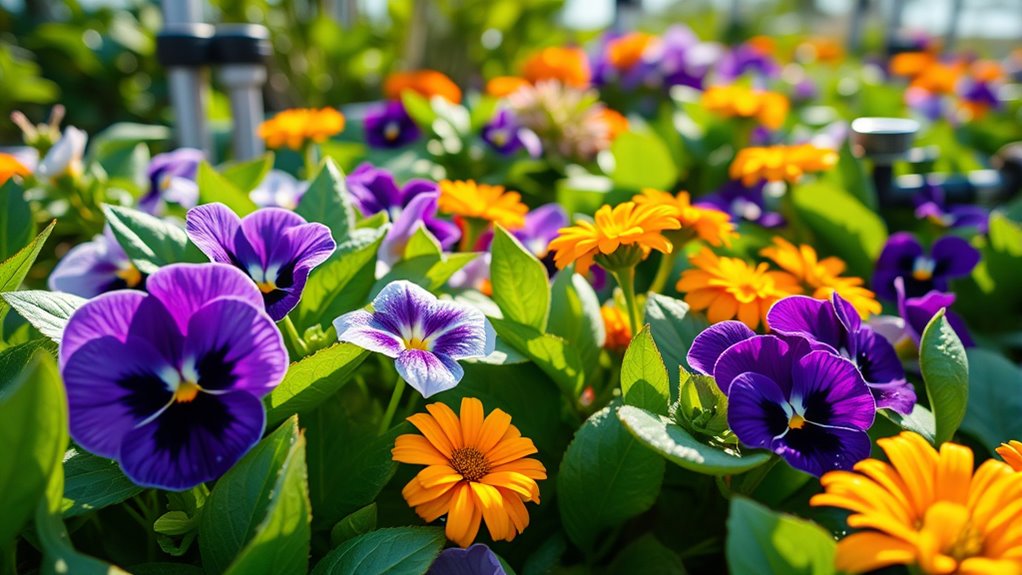
To get the best flavor and appearance, you need to harvest your flowers at the right moment. Look for signs of peak bloom, like fully open petals and vibrant color. Once picked, handle and store them carefully to preserve their freshness and edibility. Using proper harvesting techniques can also help maintain their freshness and edibility.
Optimal Harvest Timing
Timing is crucial when harvesting edible flowers to guarantee you enjoy their peak flavor, color, and aroma. Knowing when to pick depends on understanding their flower flavor profiles and seasonal blooming patterns. Generally, harvest in the morning after dew has evaporated, when flowers are fully open but not fading. For example, pansies and violets reach their best flavor early, while roses are best just before full bloom. Use this table as a guide:
| Flower Type | Prime Harvest Time | Key Flavor Notes |
|---|---|---|
| Pansies | Early morning | Mild, slightly sweet |
| Roses | Just before full bloom | Fragrant, delicate |
| Calendula | Full bloom | Peppery, tangy |
| Nasturtiums | Mid-bloom | Peppery, tangy |
| Marigolds | When petals are open | Slightly bitter |
Harvest at the right moment to maximize flavor and culinary appeal. Being aware of the seasonal blooming patterns can help you plan your harvest for the best results.
Signs of Peak Bloom
Recognizing the signs of peak bloom guarantees you harvest edible flowers at their flavor and visual best. Key bloom indicators include vibrant petal coloration, fully open flowers, and a firm structure. When petals display intense, consistent colors, it’s a clear sign they’re at their peak. Watch for flowers that are fully open, with petals spread wide and undamaged. Additionally, petals should feel firm and fresh, not wilted or browning. These indicators assure the flowers are at their most flavorful and visually appealing. Timing your harvest based on bloom indicators maximizes their culinary and aesthetic value. Keep an eye on petal coloration, openness, and firmness to catch the perfect moment for harvesting your edible blooms. Monitoring bloom stages can help ensure you pick them at their optimal time.
Handling and Storage
Once you’ve identified that your edible flowers are at their peak bloom, handle them gently to preserve their delicate structure and vibrant appearance. Proper flower handling minimizes damage and maintains freshness. Use soft tools or your fingertips to carefully pick each bloom, avoiding squeezing or crushing. After harvesting, follow storage tips to extend their usability. Rinse flowers gently with cool water, then pat dry with a soft towel to prevent moisture buildup. Store them in a breathable container, like a paper-lined box or a perforated container, in the refrigerator’s crisper drawer. Keep them away from direct sunlight and strong odors, which can affect flavor and appearance. Effective handling and storage ensure your edible flowers stay fresh, vibrant, and ready to enhance your dishes. Additionally, understanding the importance of local laws and resources can help you access the best tools and guidance for successful cultivation and usage.
Creative Ways to Incorporate Edible Flowers Into Foods and Drinks
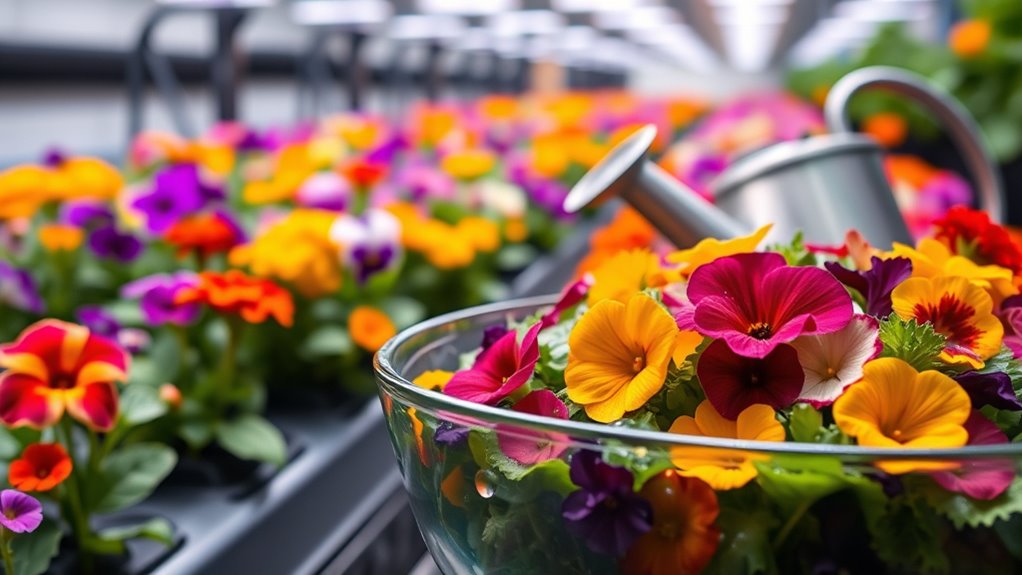
Edible flowers offer a vibrant and versatile way to elevate your culinary creations, adding both visual appeal and unique flavors. You can incorporate them in various ways, inspired by their flower symbolism and edible flower history. For example:
- Garnish salads or desserts with colorful petals to enhance presentation and flavor.
- Infuse teas, cocktails, or syrups with edible flowers for subtle aroma and aesthetic appeal.
- Use flower petals as edible confetti or in baking to add texture and elegance.
- Incorporate edible flowers into your space management routines by creating dedicated areas for floral cultivation or display, making it easier to harvest and enjoy their beauty and benefits.
Preserving and Drying Edible Flowers for Later Use

After exploring creative ways to incorporate fresh edible flowers into your dishes, it’s also helpful to learn how to conserve their beauty and flavor for future use. Flower preservation allows you to enjoy their vibrant colors and delicate flavors long after harvest. Drying techniques are simple and effective methods for preserving edible flowers. You can air dry them by hanging small bundles upside down in a dark, well-ventilated space, or use a dehydrator for faster results. Ensure flowers are completely dry to prevent mold. Once dried, store them in airtight containers away from sunlight and moisture. Proper flower preservation maintains their aroma and appearance, making them perfect for teas, potpourri, or garnishes weeks or months later. Utilizing preservation methods helps retain their nutritional value and visual appeal over time.
Troubleshooting Common Issues in Growing Edible Flowers

Growing edible flowers can be rewarding, but you might encounter common issues that affect their health and appearance. To troubleshoot effectively, consider these steps:
- Identify pests early to prevent damage; pest prevention methods include natural predators or organic sprays.
- Test your soil regularly to ensure proper nutrients and pH levels, which promote healthy growth.
- Watch for overwatering or poor drainage, as excess moisture can lead to root rot and fungal diseases.
- Ensuring proper garden maintenance practices can also help prevent many common problems and promote vibrant, healthy blooms. If you notice discolored or damaged flowers, inspect for pests or mold. Adjust your pest prevention strategies accordingly, and perform soil testing to correct deficiencies. Properly managing these issues helps maintain vibrant, edible blooms. Addressing these common problems promptly guarantees your garden stays healthy and productive.
Inspiring Recipes and Presentation Ideas for Edible Flowers

Have you ever considered how edible flowers can elevate your culinary creations? They add vibrant colors and meaningful symbolism to dishes. Use flower color combinations like purple and yellow for contrast or red and white for elegance. Incorporate edible flower symbolism—like roses representing love or violets for modesty—to add depth to your presentation. For instance, garnish salads with pansies and nasturtiums to create visual interest. You can arrange flowers in patterns or layered designs to impress guests. Here’s a quick guide: website performance metrics — tracking visitor interactions can help you refine your presentation techniques.
| Flower | Color Combinations | Symbolism |
|---|---|---|
| Rose | Red & White | Love & Purity |
| Violet | Purple & Yellow | Modesty & Happiness |
| Marigold | Orange & Gold | Warmth & Creativity |
These ideas make your dishes more appealing and meaningful.
Frequently Asked Questions
Are Edible Flowers Safe for All Garden Pests?
Not all garden pests are safe to feed on edible flowers, as some can cause damage or spread disease. While edible flowers generally offer pest resistance and are safe for consumption when grown properly, you should monitor your garden for pests that might harm the plants or compromise safe consumption. Use natural pest control methods to protect your flowers, ensuring they stay healthy and safe for you to enjoy.
Can Edible Flowers Be Grown Indoors With Smart Technology?
Imagine vibrant edible flowers blooming in your cozy indoor space, their colors brightening your day. With smart gardening technology, indoor cultivation becomes effortless—you control light, water, and temperature remotely. You can grow a variety of edible flowers year-round, enjoying fresh, beautiful blooms without outdoor gardening. Smart gardening makes it simple to nurture these delicate blossoms inside, transforming your home into a lush, edible paradise.
How Do I Prevent Pollination From Affecting Edible Flower Quality?
To prevent pollination from affecting your edible flower quality, you need effective pollination control methods. Use flower protection strategies like covering blooms with fine mesh or netting to keep out pollinators. You can also hand-pollinate flowers if needed, then immediately protect them afterward. Regularly monitor your plants for signs of unwanted pollination, and remove any open flowers that could be affected, ensuring your flowers stay pristine and suitable for consumption.
Which Edible Flowers Are Most Resistant to Diseases?
You want edible flowers that resist diseases, so look for disease resistant varieties and pest tolerant species. These plants are bred to withstand common issues like fungal infections, mold, and pests, making them easier to maintain. By choosing hardy, disease-resistant options, you minimize the need for chemical treatments and guarantee your flowers stay healthy and vibrant, providing you with safe, beautiful additions to your culinary creations.
How Long Do Edible Flowers Typically Last After Harvest?
After harvest, edible flowers usually last about 1 to 3 days, but proper flower preservation can extend their freshness. To maximize their lifespan, you should refrigerate them promptly and keep them in a damp cloth or airtight container. Harvest timing also matters: pick flowers early in the morning when they’re most vibrant. By managing these factors, you guarantee your edible flowers stay fresh and flavorful longer.
Conclusion
Now that you’ve learned how to grow and use edible flowers in your smart garden, it’s time to get your hands dirty and enjoy the beauty and flavors they bring. Whether you’re adding a splash of color to your meals or impressing guests at a gathering, these blooms are your garden’s secret weapon. So, don’t wait for a knight in shining armor—start planting today and let your garden bloom like a fairy tale!

